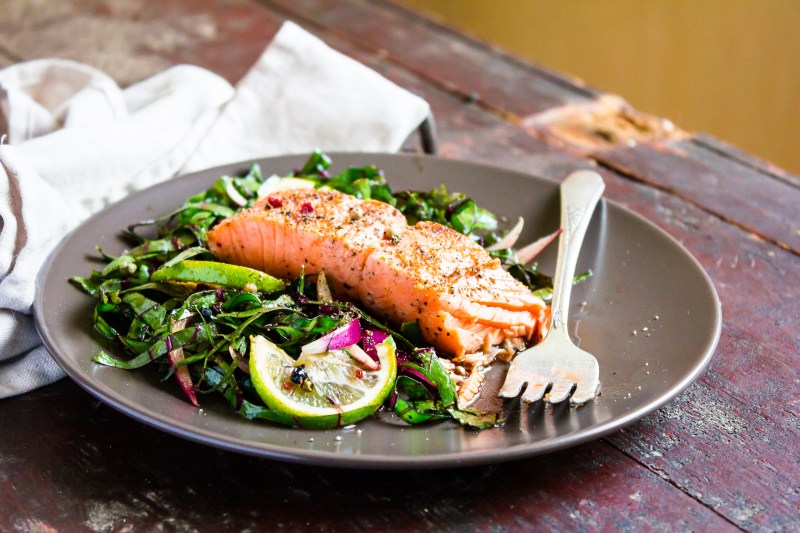Ranging from the Mediterranean diet to the DASH diet, there are many eating methods for you to choose from if you are looking to improve your health. But what about eating methods that focus on when you eat rather than what you eat? As a nutritionist, I have worked with many clients who have found that intermittent fasting makes reaching their goals that much easier. So, what exactly is intermittent fasting?
In order to get the best information, we spoke with Kayla Girgen, RD, LD, a registered dietician and founder of Nutrition Untapped. Keep reading to discover everything she had to say about fasting to see if it is something you should try!
What is intermittent fasting?

Intermittent fasting is an umbrella term used to describe a couple of different patterns or structures of timed eating intervals interspersed with timed fasting intervals. Some of the most common types of intermittent fasting include the following:
- Time-restricted eating (TRE) or time-restricted feeding (TRF): Girgen said that TRE and TRF are interchangeable terms and refer to a reduced “eating window,” but there are many different ways to actually practice this. “It is often represented as the number of fasting hours to non-fasting hours and totals 24 hours. For example, one of the most common methods is 16:8, which involves fasting for 16 hours with an 8-hour eating window,” she explained. “This method is as simple as skipping breakfast. A person might break a fast with their first meal at 12 p.m. and finish their last meal by 8 p.m.”
- 5:2 method: According to Girgen, the 5:2 method involves restricting dietary intake to no more than 600 calories per day for men (500 calories or less for women) for two days of the week. “The calorie-restricted days should not be consecutive,” she said. “On the remaining 5 days, you eat normally.”
- Alternate Day Fasting (ADF): ADF involves fasting for 24 consecutive hours as frequently as every other day.
Benefits of intermittent fasting

“Scientific evidence shows that intermittent fasting can help with weight management, improve insulin sensitivity, and reduce blood pressure,” Girgen explained. “The newest research shows promise of intermittent fasting in preventing neurodegenerative diseases such as Alzheimer’s.” Research also shows that intermittent fasting can reduce oxidative stress and inflammation.
Additional benefits of intermittent fasting include the following:
Weight loss
Weight loss is often a primary goal when it comes to any sort of structured diet, and according to Girgen, intermittent fasting can certainly be a successful weight loss approach for some. “Intermittent fasting can facilitate weight loss with little to no adverse side effects. Best of all, it’s free, and it can help add structure to your eating routine without much variance in what you eat,” she noted.
Improved insulin sensitivity
One of the primary benefits of intermittent fasting as a dietary approach to improved health and weight loss is to improve blood sugar control by reducing insulin secretion from the pancreas. When carbohydrates are ingested and released into the bloodstream as glucose (blood sugar), the pancreas is signaled to release insulin because insulin stimulates the cells to take up and absorb the circulating glucose. “When insulin is present in the bloodstream, we have a higher likelihood of storing fat versus using it for energy,” Girgen explained. “Chronic exposure to insulin can also result in insulin resistance, which is the primary cause of type II diabetes.”
Studies show that intermittent fasting can be helpful for reducing the frequency of insulin secretion and thus the resistance to it because there are fewer times, or a more limited window of time, in which the body is in a “fed” state with surges of blood sugar.
Autophagy
Intermittent fasting helps activate what is referred to as autophagy, a term that refers to cellular clean-up in the body. Autophagy, which was discovered in 2016 by Yoshinori Ohsumi, a cell biologist awarded the Nobel Prize in Medicine for his discoveries, has been shown to help with cellular renewal, inflammation, and longevity.
Flexibility
In terms of dietary approaches, one of the primary benefits of intermittent fasting is that it’s flexible. “A person might fast for 16 hours per day during the workweek, and on weekends, their eating window might be longer so they can enjoy brunch with family or accommodate social outings later in the evening,” Girgen shared. “There are no hard-and-fast rules for intermittent fasting, though some individuals are stricter (on when and what they eat) than others.”
Drawbacks of intermittent fasting

Girgen says that hunger is a common fear when starting intermittent fasting. “It’s true that hunger may be experienced in the beginning, but your body adjusts to this over time. Hunger isn’t a bad thing. On the other hand, intermittent fasting should not be miserable,” Girgen said. “Many people find they have more energy when they fast,” who advises that you should listen to your body and progress into intermittent fasting gradually.
“Headaches can be another initial side effect of intermittent fasting,” Girgen continued. “To prevent them, be sure to drink plenty of water. Herbal tea and black coffee are also allowed.” She also recommends drinking electrolyte water or adding a pinch of salt to your water, depending on the length of your fast, to help regulate your electrolytes.
In addition to these potential drawbacks, intermittent fasting may be contraindicated for certain people depending on their health status and history. Girgen said that anyone interested in experimenting with intermittent fasting should consult their physician, particularly those with the following conditions:
- Type I or II diabetes (especially if you take oral medications or insulin which put you at risk for hypoglycemia)
- Low blood pressure
- Electrolyte imbalances
- On prescription medications
She added that intermittent fasting is not appropriate for individuals who:
- Are pregnant or breastfeeding
- Are adolescents and still growing (<20 years old)
- Are underweight (BMI <18.5 kg/m2)
- Have an active eating disorder
- Have advanced kidney or heart disease
How do you do intermittent fasting?

Technically, we all fast to some degree daily. Every night, when you sleep, you are fasting. In fact, the word “breakfast” literally means to “break the fast.” If you happen to be the type of person who skips breakfast, you’re already unknowingly doing a version of intermittent fasting, probably along the lines of the 16:8 method. So, if you want to delve more deeply into intermittent fasting as a dietary approach, you would simply begin by being more deliberate in your fasting and eating windows and gradually modifying those intervals.
“The best intermittent fasting regimen is one that you will stick to,” Girgen advised. “It can be done short- or long-term. It is a great weight management tool, and many clients I have worked with have voiced that it is something they will practice life-long.”
Intermittent fasting best practices

It’s vital to remember that intermittent fasting is ultimately only a tool, and its success as a weight loss diet is contingent upon how you use the strategy and your food and lifestyle choices. “Gorging or overeating the second your eating window opens should be avoided,” Girgen cautioned. “To reap the most benefits from intermittent fasting, you have to be mindful of diet quality. Focus on minimally processed whole foods such as high-quality meats and animal products, vegetables, and healthy fats like avocado, olive oil, nuts, etc.”
Not sure what that looks like practically? Girgen had some advice: “I like to recommend my clients follow the 80/20 rule: 80% of what goes in your mouth is healthy, mostly whole food, and the remaining 20% is ‘fun food.’ These proportions may be adjusted to 70/30 or 90/10, for example, depending on your metabolism and health goals, but the same principles apply.”
As with any of the best diets, in order for intermittent fasting to be successful, you have to make it work for you in a sustainable way. It’s key to listen to your body to determine if you’re feeling better or worse as you play with your eating and fasting windows and adjust accordingly. Remember, your metabolism, physiology, lifestyle, and preferences are unique, so what may work best for you may be different than what works best for someone else.
Example day of eating for optimal health

If you want to give intermittent fasting a go, you may want to start with the most popular method — an 8-hour eating window. While everyone’s schedule is different, you may find breaking your fast at 12 p.m. and resuming your fast at 8 p.m. to work well. Here’s an example of a balanced day of eating:
- 12 p.m. (first meal) – Grilled salmon with quinoa and roasted vegetables, plus a side of avocado for healthy fats
- 3 p.m. (first snack) – Greek yogurt with mixed berries and a handful of almonds
- 6:30 p.m. (second meal) – Grass-fed beef stir-fry with brown rice and steamed broccoli
- 7:45 p.m. (lighter second snack) – Cottage cheese with cinnamon and walnuts or a protein smoothie
Adjust this day of eating so it makes sense for you, but this plan prioritizes whole, nutrient-dense foods to support energy, muscle maintenance, and overall well-being. Drinking plenty of water throughout the fasting and eating periods is essential as well.
Intermittent fasting FAQs

You know about the intermittent fasting benefits, but you probably still have questions before jumping into this practice. Here are the FAQs.
Is it better to fast for 12 or 16 hours?
Fasting for 12 or 16 hours provides benefits. Keep in mind that 16 hours is often considered the magic number for fasting because it could lead to a greater depletion of glycogen stores. You’ll probably eat fewer calories overall in this condensed 8-hour eating window, which could promote more weight loss and fat burning.
As Girgen explained, a popular fasting method is 16:8, which is as simple as skipping breakfast. If you can last without eating from 8 p.m. in the evening after dinner until noon the next day when you can break your fast with lunch, then you can practice 16:8 intermittent fasting. With 12 hours, you’re shortening that fasting window, and it might be better for first-timers or people who struggle and don’t feel well going hours without food.
Is it OK to fast for 16 hours every day?
Practicing 16:8 intermittent fasting can be advantageous for a while, but most health experts believe it isn’t a good idea to do so every day in the long term. For example, studies reveal that people who frequently fast more than 16 or 18 hours a day have an increased risk of gallstones and are more likely to need surgery to remove the gallbladder.
Some experts believe 12:12 fasting is safe for most people, where you eat for 12 hours and fast for 12 hours. If you’re unsure how you’ll handle fasting, start with a 12-hour fast and see how you feel. Consume healthy meals when breaking your fast.
What is the rule for intermittent fasting?
With all the variations of intermittent fasting, there aren’t steadfast rules on exactly how to do it. Each type of fasting has clear rules on the number of hours you’re supposed to refrain from eating in a 24-hour period. Some people drink coffee and no-calorie beverages while fasting, and others take electrolytes. Others add butter to their coffee.
Start by skipping breakfast here and there and work your way up to larger fasting windows over time. As Girgen stated, “There are no hard-and-fast rules for intermittent fasting,” so it’s up to you how strict you’d like to be.
What is the best intermittent fasting time?
Some people agree that the popular 16:8 intermittent fasting schedule is easiest to implement after lunch. After a late lunch, around 3 p.m., you fast until around 7 a.m. the next morning when you eat a healthy breakfast. This time-restricted feeding works best for early birds and people who like to eat earlier in the morning but don’t mind skipping dinner. Others prefer fasting after a nice evening meal to accommodate social outings in the evening and prevent them from giving in and binging on unhealthy snacks while watching TV.
Someone might choose to fast for 16 hours during weekdays and only 12 hours on the weekends when they’re often busy with family and friends. The 5:2 intermittent fasting schedule is also popular, where you restrict calories to 500 to 600 five days a week and eat normally for the remaining two days.
How do you do intermittent fasting correctly?
If you’re unsure about fasting, it’s best to discuss it with your healthcare provider. The idea is to choose an intermittent fasting schedule and stick to it. If you’ve chosen the 5:2 schedule, you’ll need to restrict your calories for five days of the week, so you should plan ahead and decide what days would work best.
Intermittent fasting can come along with uncomfortable side effects like hunger, fatigue, and insomnia, but these tend to go away within a month. Girgen rightly noted that hunger isn’t necessarily a bad thing, but you shouldn’t feel miserable while fasting. Intermittent fasting isn’t the right choice for everyone. For example, pregnant or breastfeeding women or people with certain medical conditions should avoid fasting.




